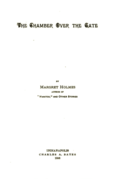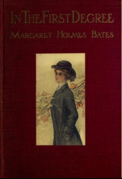Margret Holmes Bates
Margret Holmes Bates | |
|---|---|
 | |
| Born | Martha Mary Victoria Ernsperger October 6, 1844 Fremont, Ohio, U.S. |
| Died | January 21, 1927 (aged 82) New York City New York, U.S. |
| Pen name |
|
| Occupation | Author |
| Nationality | American |
| Genre |
|
| Notable works | Hildegarde |
| Spouse |
Charles Austin Bates
(m. 1865) |
| Children | Charles Bates |
Margret Holmes Bates (née, Martha Mary Victoria Ernsperger; October 6, 1844 – January 21, 1927) was an American author better known by her pen names, Mrs M E Holmes, Margret Holmes, Margret Holmes Bates, and Margaret Holmes Bates. Her first publication was entitled, Manitou, the plot of which centered around Rochester, Indiana and Indianapolis, Indiana. One of her most noted books, Hildegarde, was a poetry collection, dedicated to her son, Charles.[1]
Early life and education[edit]
Martha Mary Victoria Ernsperger[1] was born in Fremont, Ohio on October 6, 1844, a daughter of Christopher, a farmer,[2] and Julia (Ensminger) Ernsperger,[3] both of purely German descent. Her father was born in Baltimore but after he had attained his majority, he settled in northern Ohio. From Ohio, he removed to Rochester, Indiana in 1858. Her mother's family was from Pennsylvania.[4][5]
During her childhood, she showed great fondness for books, and as a school-girl, the weekly or fortnightly "composition" was to her a pleasant past-time, a respite from the duller, more prosaic studies of mathematics and the rules of grammar. It was her delight to be allowed, when out of school, to put her fancies into form in writing, or to sit surrounded by her young sisters and baby brother and tell them stories as she thought of them.[6][5] She spent her girlhood in Rochester, Indiana,[1] and was educated in the public schools of Ohio.[3]
Career[edit]
Bates taught school in Rochester for many years.[1] In June 1865, she married Charles Austin Bates, a businessman,[2] of Medina, New York. After her marriage, her home was in Indianapolis. Fascinated for several years after her marriage with the idea of becoming a model housekeeper, and conscientious to a painful degree in the discharge of her duties as a mother, she wrote nothing for publication, and but little, even at the solicitations of friends, for special occasions. This way of life, unnatural for her, proved unhealthful.[6][5] Some of her poems attracted wide attention. The poem, "Nineveh", was an epitome of her life.[6][5] One of her most noted books, Hildegarde, was a poetry collection, dedicated to her son, Charles.[1]
Her first novel, Manitou (1881), was written at the request of her son. It embodies a legend connected with the lake of that name in northern Indiana, in the vicinity of which Bates lived for several years before her marriage. The Chamber Over the Gate (Indianapolis, 1886) had a wide sale. Other books included, The price of the Ring (1892), Shylock's Daughter (1894), Jasper Fairfax (1897), In the First Degree (1907), Hildegarde and Other Lyrics (1911), and Browning Critiques (1927).[6][5]
In addition to poetry and novels, she wrote short stories, business articles, book reviews,[3] and school primers.[2] When good health seemed to evade her, she turned to writing for pastime and wrote much for newspapers and periodicals.[6][5] She was the editor-in-chief of Tatler, a monthly magazine established in Indianapolis in 1887.[7]
Bates served on the Executive Committee of the Western Association of Writers,[6][8] before removing to New York City in 1894.[2] She was a charter member of the Browning Society of New York and an honorary member of the Indiana Society of New York.[1] She was a member of Daughters of Ohio in New York, Daughters of Indiana in New York, and the Playgoers Club. In religion, she was Episcopalian. She supported women's suffrage.[3]
Death[edit]
After three days of illness, Margret Holmes Bates died of heart disease at her home in New York City on January 21, 1927, aged 82.[1]
Selected works[edit]
Books[edit]
As Margret Holmes[edit]
- Manitou (Indianapolis : Carlon & Hollenbeck, Printers and Binders, 1881)
- The Chamber over the Gate (Indianapolis : C.A. Bates, 1886)
- Her fatal sin (Chicago : Laird & Lee, 1886)
- A Heartless Woman; Or, Love and Deceit (Chicago : Laird & Lee, 1886)
- The Tragedy of Redmount (Chicago : Laird & Lee, 1886)
- Dialogues for Christmas (Indianapolis : Charles A. Bates, 1887)
- Recitations for Christmas (New York : The De Witt Publishing House, 1887)
- Little dialogues for little people (New York : De Witt publishing house, 1889)
- Select dialogues for young people (Chicago : Donohue, Henneberry, 1891)
- The price of the Ring (Chicago : F.J. Schulte & Co., 1892)
- Shylock's Daughter (Chicago : C.H. Kerr, 1894)
- Jasper Fairfax, (New York : R. F. Fenno, 1897)
As Margret Holmes Bates[edit]
- Silas Kirkendown's sons (Artwork by R. Stebbins; Boston : The C.M. Clark Publishing Co. 1908)[a]
- Paying the Piper (New York : Broadway Publishing Co., 1910)
- Hildegarde and Other Lyrics (New York : Broadway Publishing Co. , 1911)
- Select readings and recitations for all the year round : Labor Day, Thanksgiving Day, Christmas and New Year, Washington's Birthday, Easter, Memorial Day (Lebanon, Ohio : March Bros., 1914)
- Browning critiques (Chicago : The Morris Book Shop , 1921)
As Margaret Holmes Bates[edit]
- In the First Degree (New York, R.G. Cooke, Inc., 1907)
Poetry[edit]
- "My Indian Basket"
- "Nineveh"
Gallery[edit]
-
Manitou (1881)
-
The Chamber over the Gate (1886)
-
The Price of the Ring (1892)
-
Jasper Fairfax (1897)
-
Little dialogues for little people (1889)
-
In The First Degree (1907)
-
Silas Kirkendown's Sons (1908)
-
Paying the Piper (1910)
-
Hildegarde, and other lyrics (1911)
-
Browning Critiques (1921)
Notes[edit]
- ^ The author name, Margret H. Bates, is imprinted on the Silas Kirkendown's Sons (1908) book cover, but the author name on the frontispiece is Margret Holmes Bates.
References[edit]
- ^ a b c d e f g "Obituary for Margret Holmes Bates, author born Martha Mary Victoria Ernsperger". The Star Press. January 23, 1927. p. 7. Retrieved December 12, 2021 – via Newspapers.com.
- ^ a b c d Rosenthal 2004, p. 154.
- ^ a b c d Leonard 1914, p. 83.
- ^ Moulton 1891, pp. 173–174.
- ^ a b c d e f Willard & Livermore 1893, p. 64.
- ^ a b c d e f Moulton 1891, pp. 173–74.
- ^ Ayer 1887, p. 290.
- ^ Wheeler & Cardwill 1890, p. 18.
Attribution[edit]
 This article incorporates text from this source, which is in the public domain: Ayer, N.W. (1887). N. W. Ayer & Son's American Newspaper Annual (Public domain ed.). N.W. Ayer and Son.
This article incorporates text from this source, which is in the public domain: Ayer, N.W. (1887). N. W. Ayer & Son's American Newspaper Annual (Public domain ed.). N.W. Ayer and Son. This article incorporates text from this source, which is in the public domain: Leonard, John William (1914). Woman's Who's who of America: A Biographical Dictionary of Contemporary Women of the United States and Canada, 1914-1915 (Public domain ed.). American Commonwealth Company.
This article incorporates text from this source, which is in the public domain: Leonard, John William (1914). Woman's Who's who of America: A Biographical Dictionary of Contemporary Women of the United States and Canada, 1914-1915 (Public domain ed.). American Commonwealth Company. This article incorporates text from this source, which is in the public domain: Moulton, Charles Wells, ed. (1891). "Margret Holmes Bates, by W. DeW. W". The Magazine of Poetry and Literary Review. 3.
This article incorporates text from this source, which is in the public domain: Moulton, Charles Wells, ed. (1891). "Margret Holmes Bates, by W. DeW. W". The Magazine of Poetry and Literary Review. 3. This article incorporates text from this source, which is in the public domain: Wheeler, L. May; Cardwill, Mary E. (1890). Western Association of Writers: Souvenir of the Fourth Annual Convention at Warsaw, Indiana: July 9, 10, 11, and 12, 1889 (Public domain ed.). M. Cullaton & Company.
This article incorporates text from this source, which is in the public domain: Wheeler, L. May; Cardwill, Mary E. (1890). Western Association of Writers: Souvenir of the Fourth Annual Convention at Warsaw, Indiana: July 9, 10, 11, and 12, 1889 (Public domain ed.). M. Cullaton & Company. This article incorporates text from this source, which is in the public domain: Willard, Frances Elizabeth; Livermore, Mary Ashton Rice (1893). "Margaret Holmes Bates". A Woman of the Century: Fourteen Hundred-seventy Biographical Sketches Accompanied by Portraits of Leading American Women in All Walks of Life (Public domain ed.). Charles Wells Moulton.
This article incorporates text from this source, which is in the public domain: Willard, Frances Elizabeth; Livermore, Mary Ashton Rice (1893). "Margaret Holmes Bates". A Woman of the Century: Fourteen Hundred-seventy Biographical Sketches Accompanied by Portraits of Leading American Women in All Walks of Life (Public domain ed.). Charles Wells Moulton.
Bibliography[edit]
- Rosenthal, Debra J. (2004). Race Mixture in Nineteenth-century U.S. and Spanish American Fictions: Gender, Culture, and Nation Building. Univ of North Carolina Press. ISBN 978-0-8078-5564-5.
External links[edit]
 Works related to Woman of the Century/Margaret Holmes Bates at Wikisource
Works related to Woman of the Century/Margaret Holmes Bates at Wikisource- Works by or about Margret Holmes Bates at Internet Archive
- Works by or about Margaret Holmes Ernsperger Bates at HathiTrust
- 1844 births
- 1927 deaths
- 19th-century pseudonymous writers
- 20th-century pseudonymous writers
- 19th-century American novelists
- 19th-century American short story writers
- 19th-century American poets
- 19th-century American non-fiction writers
- 20th-century American novelists
- 20th-century American short story writers
- 20th-century American poets
- 20th-century American non-fiction writers
- Pseudonymous women writers
- Writers from Ohio
- People from Fremont, Ohio
- American magazine editors
- American women novelists
- American women poets
- Episcopalians from Ohio










